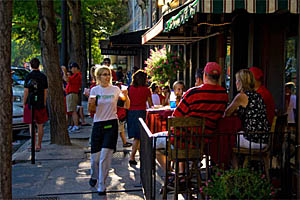
“Many studies have shown that urban sprawl is associated with more driving and less public transit use,” said Dr Holian. “However, the existing literature provides little guidance for policy makers on how to reverse sprawl and reduce vehicle emissions. Our report suggests that a vibrant urban core may plausibly affect land use and transportation patterns. So, that leaves us with a key question. Can policy makers promote green cities by fostering a vibrant center core?”
Based on their findings, the authors believe this can happen if policy makers rethink current land-use regulations; continue investments to reduce center city crime; and increase local public school quality. The authors also recommend areas for further study.
This report addresses two primary goals. First, it generates new econometric results using several new micro and macro data sets to quantify how proximity to the city center affects a household’s GHG production from driving, as well as its likelihood of using public transit. And second, it examines the effect of downtown vibrancy on transportation and land use. As a result, the authors are able to provide estimates of the size of GHG reductions that will result from changes in land-use and vibrancy.
The authors recognize that “vibrancy” can be a hard-to-define concept. However, they outline objective indicators that they believe correlate with what most people seek out in city centers in terms of employment, leisure, and other opportunities. They define “vibrancy” based on the downtown’s share of residents who are college graduates, the crime rate, the number of cultural and consumer-oriented establishments, and the downtown share of a metropolitan area’s jobs and population growth.
According to the report, data analysis from a large, national survey of US households in 2009, supplemented with the vibrancy measures, uncovers new knowledge about economically and statistically significant relationships among vibrancy, emissions, and public transit use. Many of these relationships are verified through analyses of data from multiple sources.
Among the findings:
- Between 2000-2010, metropolitan areas with more vibrant downtowns experienced less sprawl. San Francisco, Miami, and New York experienced sprawl rates of less than one percent, while Memphis, Tucson, and Phoenix had sprawl rates greater than ten percent.
- If downtown is a place where people want to be, then they will live closer to it. Therefore, one effect of vibrancy is to influence land-use patterns. In turn, land-use patterns influence driving and public transit use.
- By encouraging sprawl, federal home ownership policies have unintentionally increased greenhouse gas emissions.
- When established cities block new construction, it forces people to seek housing in far-flung suburbs, where their carbon footprint will be greater.
The report is divided into five sections that address urban growth in the 2000s; household GHG production from driving; a macro-level study of GHG production; household public transit use; and a macro-level study of public transit use.
The complete 90-page report includes 34 tables that illustrate key issues and findings. It is available for free PDF download at transweb.sjsu.edu/project/1002.html
ABOUT THE RESEARCH TEAM
Matthew J. Holian, PhD, is an assistant professor at San Jose State University in the Economics Department and a research associate at the Mineta Transportation Institute. He completed his PhD in economics in 2008 at Ohio State University. His scholarly publications have appeared in journals such as Journal of Housing Economics and Public Choice. His research focuses on industrial, public, transportation, and urban economics.
Matthew E. Kahn, PhD, is a professor at the UCLA Institute of the Environment, the Department of Economics, and the Department of Public Policy. He is a research associate at the National Bureau of Economic Research and the Mineta Transportation Institute. Before joining the UCLA faculty in January 2007, he taught at Columbia and the Fletcher School at Tufts University. He has been a visiting professor at Harvard and Stanford. He holds a PhD in economics from the University of Chicago. He is the author of Green Cities: Urban Growth and the Environment (Brookings Institution Press, 2006) and Climatopolis (Basic Books, 2010), and the co-author of Heroes and Cowards: The Social Face of War (Princeton University Press, 2009). His research focuses on environmental, urban, real estate, and energy economics.



